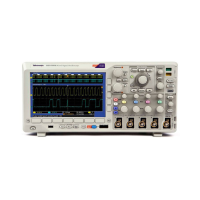Analyze Wavefor
mData
7. The FFT will app
ear on the display.
Quick Tips
Use short record lengths for faster instrument response.
Use long record lengths to lower the noise relative to the signal and increase the frequency resolution.
If desired, use the zoom feature along with the horizontal Position and Scale controls to magnify and position the
FFT waveform.
Use the default dBV RMS scale to see a detailed view of multiple frequencies, even if they have very different amplitudes.
Use the l
inear RMS scale to see an overall view of how all frequencies compare to each other.
The FFT f
eature provides four windows. Each is a trade-off between frequency resolution and magnitude accuracy.
What you want to measure and your source signal characteristics help determine which window to use. Use the following
guidelines to select the best window.
Description Window
Rectan
gular
This is the best type of window for resolving frequencies that are very c lose to the same
value but worst for accurately measuring the amplitude of those frequencies. It is the best
type f
or measuring the frequency spectrum of nonrepetitive signals and measuring frequency
components near DC.
Use Rectangular for measuring transients or bursts w here the signal level before and after the
even
t are nearly equal. Also, use this window for equal-amplitude sine waves with frequencies
that are very close and for broadband random noise with a relatively slow varying spectrum.
Hamm
ing
This is a very good window for resolving frequencies that are very close to the same value
with somewhat improved amplitude accuracy over the r ectangular window. It has a slightly
bet
ter frequency resolution than the Hanning.
Use Hamming for measuring sine, periodic, and narrow band random noise. This window
works on transients or bursts where the signal levels before and after the event are
sig
nificantly different.
114 MSO3000 and DPO3000 Series O scilloscopes User Manual

